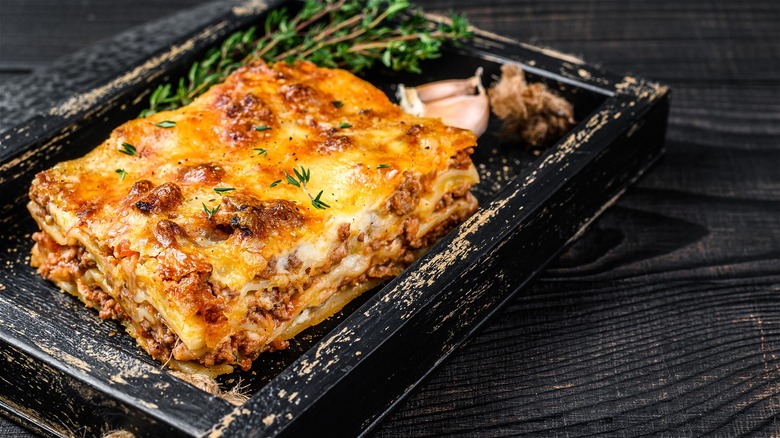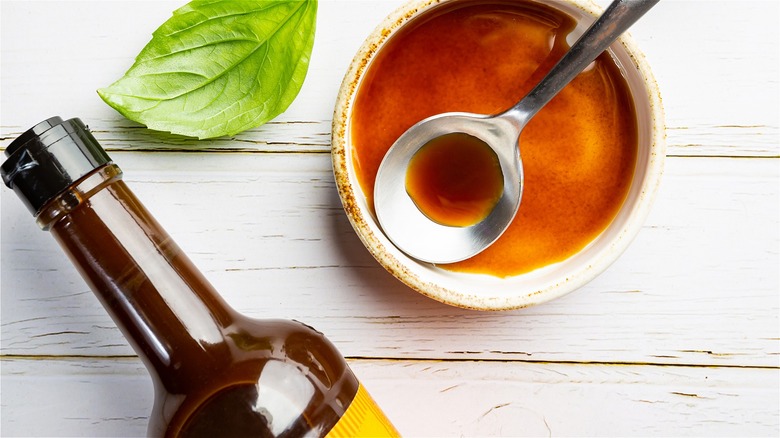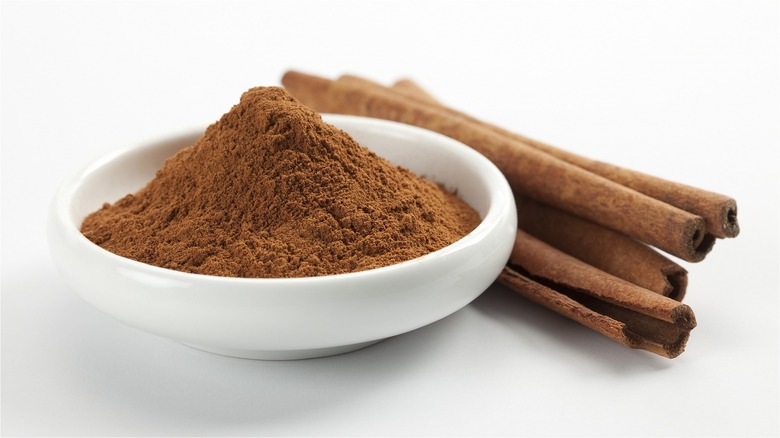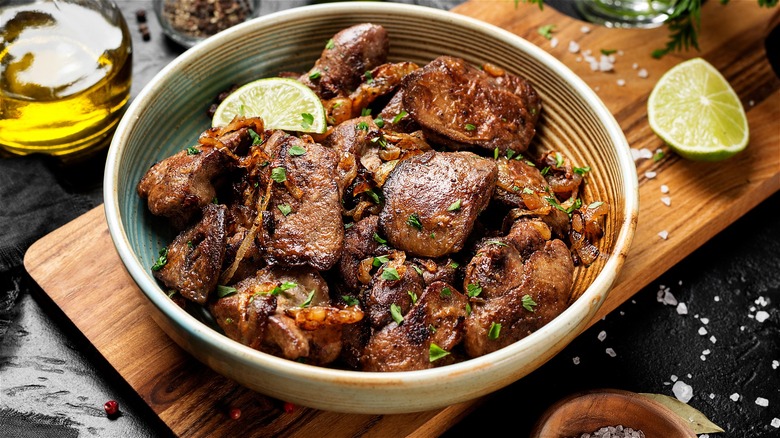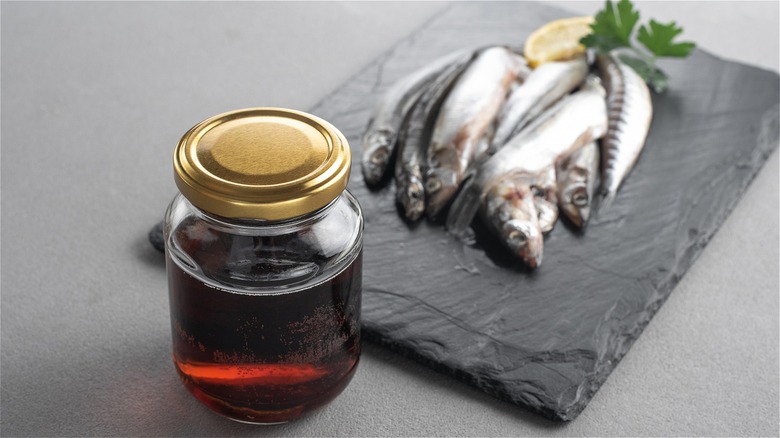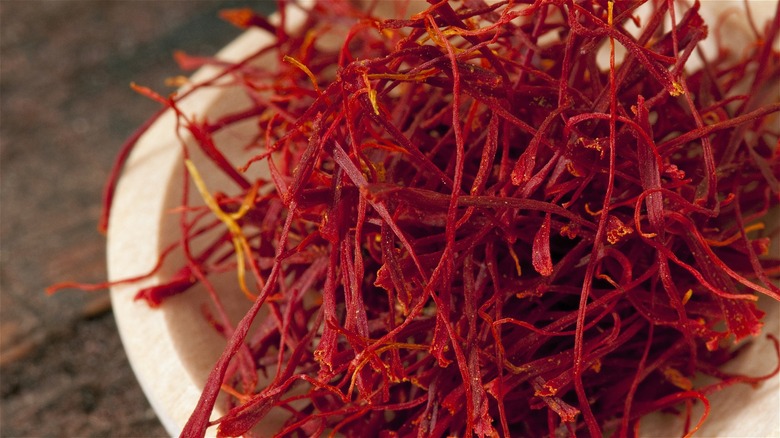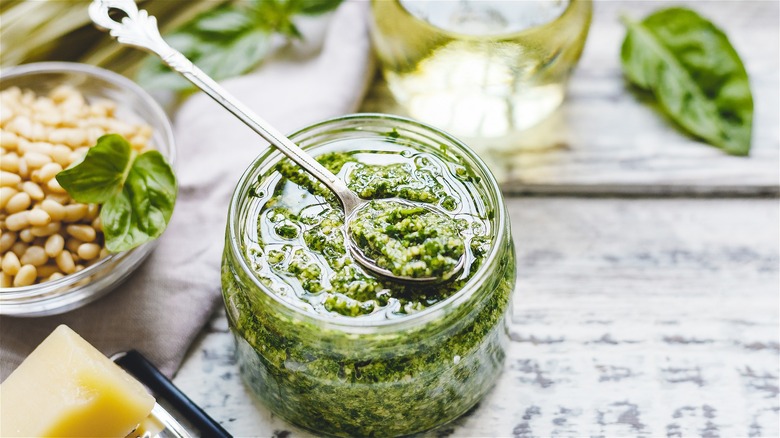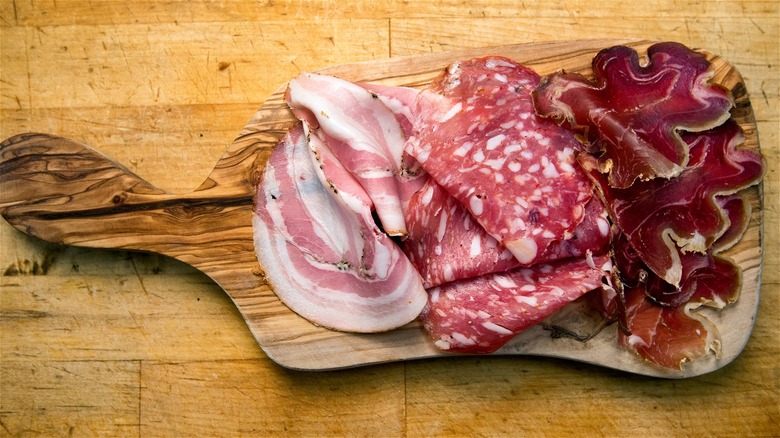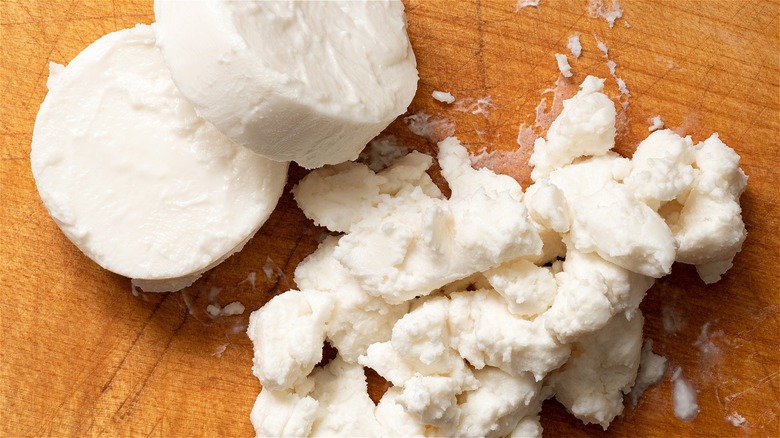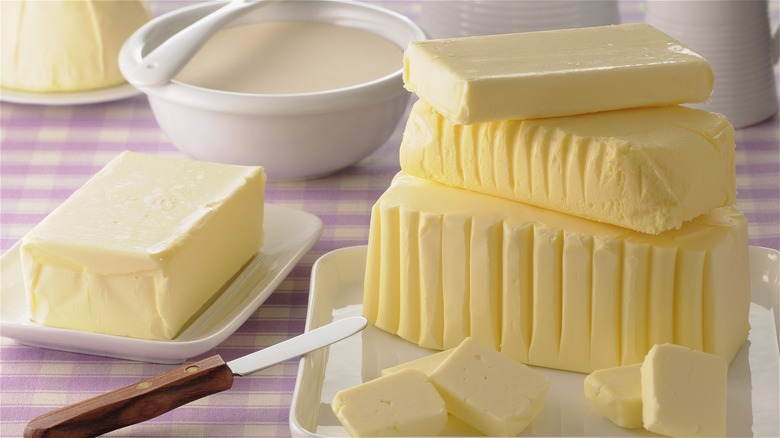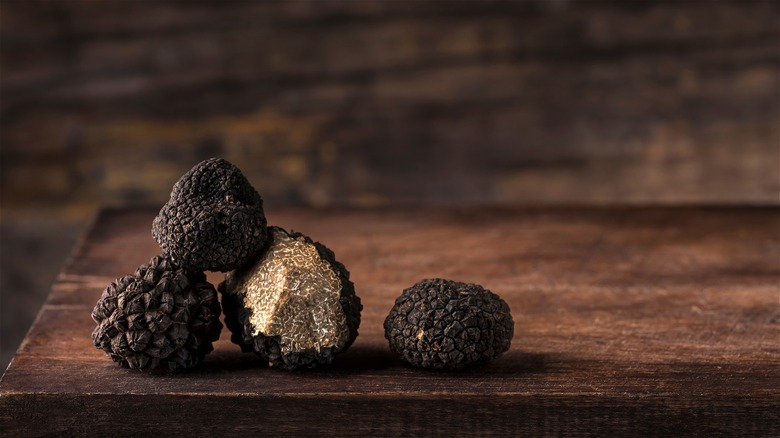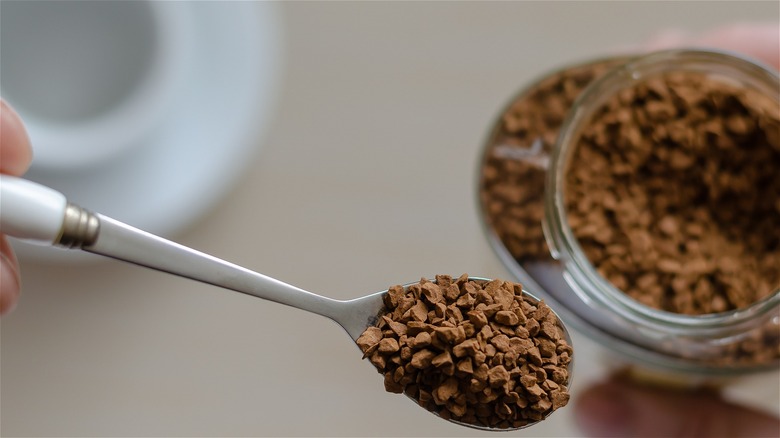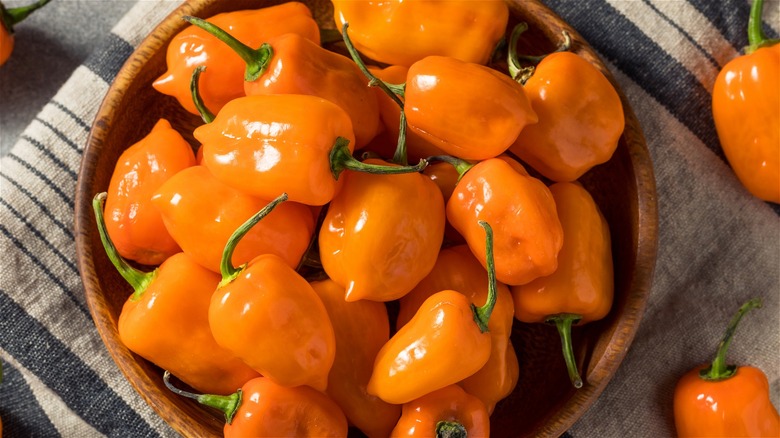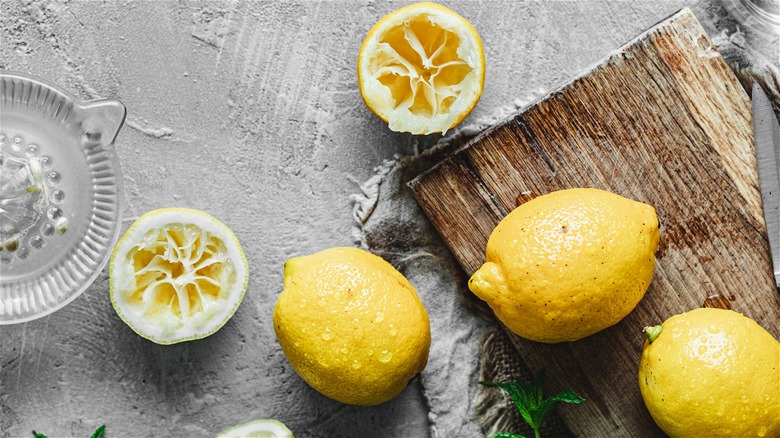13 Unexpected Ingredients To Elevate Lasagna
These days it seems like there are almost as many twists on lasagna as there are people on the planet. The dish can be cooked in cast iron skillets, loaf pans, or even slow cookers. If you want to try something new, you can find a variation to suit every palate, from rich seafood lasagnas to autumnal butternut squash lasagnas. Recipes that are close to a more classic interpretation of the dish sometimes have a less-than-traditional cooking method. Some versions push the very definition of the name "lasagna" (we're looking at you, chocolate lasagna), applying it to anything with stacked layers. (Lasagna roll-ups are proof that lasagna doesn't even have to be stacked.)
But what if you're a fan of traditional lasagna layered with meat, cheese, and sauce and baked in a casserole dish? If you have a tried-and-true classic lasagna recipe you already love, there's no need to ditch it for a new one. There are ingredients you can add to your favorite recipe to give it a little more oomph while still maintaining a lasagna's integrity. Which one should you try? Consider what it is you want from your lasagna. Whether you'd like more depth of flavor, a touch of heat, or something more ineffable, there's an ingredient here that will truly take your favorite lasagna to the next level.
Worcestershire sauce
While making a lasagna, one of the most important steps is making the Bolognese sauce. When you think about the components that make up a lasagna, you'll notice that the sauce is where most of the flavor lies. The pasta and cheese may have their charms, but a flavorful sauce is crucial to a lasagna that everyone remembers. One simple way to add depth of flavor without adding a zillion more ingredients is to include a bit of Worcestershire sauce in your lasagna's sauce. Start with a few drops as you sauté the vegetable and meat ingredients (so they'll soak up the flavor), and add a little more to taste as you go.
A few drops may not seem like very much, especially if your goal is to transform and elevate your lasagna but keep in mind that Worcestershire sauce is concentrated. It also contains a long list of flavorful ingredients, so using it is like adding vinegar, molasses, anchovies, cloves, tamarind, chili peppers, and several more elements. You wouldn't want gobs of any of those ingredients to overpower your lasagna by themselves, but in tandem and used with a light hand, they transform lasagna into an expertly crafted dish.
Cinnamon
Americans often have a narrow view of cinnamon as an ingredient. While it's a welcome component in sweet baked goods like cinnamon rolls and Snickerdoodle cookies, many have yet to embrace the spice as a worthy addition to savory dishes. This certainly isn't the case around the world. In Mexico, for example, cinnamon isn't just for dusting churros but is equally welcome in a batch of spicy, chile-laden mole sauce. In India, cinnamon is a component of garam masala, the heady spice blend that enhances savory dishes from tandoori chicken to spinach dal.
Adding cinnamon to the ricotta layer of lasagna brings warmth and aroma to the dish, enhances its overall flavor, and makes it seem even more comforting. It's the secret ingredient of many an Italian grandma, and even Tony Bennett's mom used it in her lasagna — the late crooner even shared the recipe on Twitter several times. Some opt for adding nutmeg instead, and some throw caution to the wind and add both. Subtlety is key, so don't add more than a pinch (or ¼ of a teaspoon for those who measure everything).
Chicken livers
Not everyone is a fan of chicken livers, but those who love them understand the richness and flavor they contain. They're a staple of French cuisine, so it's no surprise that Julia Child was a fan of using them in her cooking, and so is Jacques Pepin. Dishes like chicken liver toast and chicken liver mousse are common on menus at finer restaurants. When it comes to elevating a lasagna, the flavor of chicken livers decidedly moves the dish further away from being an everyday casserole and more into the category of haute cuisine.
Chef Emeril Lagasse adds chopped chicken livers to his lasagna sauce after it has already been simmering for 45 minutes to an hour, but Anthony Bourdain liked to cook his chicken livers in the pan with the vegetables before adding the raw ground meat (he used a mix of beef, veal, and pork). If you're new to cooking them, choose chicken livers by the color, and don't be intimidated. Whichever way you decide to integrate chicken livers into your lasagna, you can expect the woodsy, earthy taste to take your dish to the next level.
Fish sauce
If you're a foodie, you already know that some of the tastiest dishes in the world get their kick from the addition of anchovies. Caesar dressing gets its unique taste from the salty little fish, as do many tomato-based sauces. Even Worcestershire sauce gets part of its savory deliciousness from anchovies. What you may not know is that you can get that same kick from fish sauce, which is made from anchovies that have been fermented.
You've already tasted fish sauce, even if you think you haven't. It's what gives a depth of flavor to dishes all over the globe, especially in Southeast Asia, where it's a prominent feature of Vietnamese, Thai, Chinese, Korean, and many other cuisines. Fish sauce is packed with umami flavor, which makes it a smart addition to all manner of dishes, even those that aren't Asian. The salty-savory taste works particularly well with Italian dishes to boost flavor but worry: no one will taste the fish. Add a few dashes of fish sauce to your lasagna (just stir it into your Bolognese), and all anyone will notice is enhanced flavor.
Saffron and orange peel
Lasagna is not a dish you would normally associate with Julia Child, whose culinary reputation rests largely on her expertise in French cuisine. This fact was asserted by Child herself during an episode of her classic television cooking show "The French Chef" in 1970. She mentions that she's not an Italian cook when she advises viewers to simply follow the instructions on the box for cooking the noodles. The lasagna she prepares is more of a French-style dish, she says. Child's lasagna has many personal touches, including a splash of vermouth in the béchamel.
Perhaps the biggest surprise in Julia Child's lasagna recipe is that she suggests adding a little bit of saffron and orange peel to the tomato sauce while it is simmering. These are certainly not traditional Italian ingredients, but it's worth noting that both saffron and orange zest are common ingredients in French bouillabaisse, a seafood stew. Julia Child knew flavors, and she knew that if those ingredients enhanced the broth of a tomato-based seafood stew, they could work in the sauce for lasagna. It's absolutely worth trying.
Pesto
It's surprising that pesto doesn't make more appearances in lasagna. When you consider the ingredients in pesto, each individual component is something that works great in nearly any Italian dish. Who doesn't love a bit of basil, olive oil, or Parmesan cheese? The pine nuts are more of a wild card, and yet their sweet, buttery flavor is also a welcome addition to Italian dishes. It's high time pesto and lasagna became more frequent companions. You can easily make your own homemade pesto in just a few steps or purchase one of the many jarred varieties.
Some cooks like to use pesto as a substitute for their Bolognese (and that's a great way to make your lasagna vegetarian if you so choose), but you can stick closer to your favorite recipe by considering pesto as an additional ingredient to a classic lasagna dish. Pesto mixed into the Bolognese is also an option, though you'll want to have a ratio of 3:1 with pesto the lesser. Adding pesto to the béchamel or to the ricotta layer brings a herby depth and a bright flavor to lift the heaviness of the meat and cheese. There's another perk to using pesto, which is visual contrast. The vibrant green turns a red and white lasagna into the colors of the Italian flag!
Cured meats
Plenty of ways to add more flavor to ground meat as you brown it for your lasagna. Adding dry seasonings is a no-brainer, as is cooking the meat and savory vegetables like onions and garlic and letting the flavors infuse into beef, veal, or whichever protein you've chosen for your lasagna. Something you may not have considered is flavoring your meat with ... more meat. Adding a bit of cured meat, such as bacon, ham, or prosciutto in your pan adds serious flavor, which will carry over to your sauce.
It's reported that Michelin-starred British chef Paul Heathcote begins his classic lasagna recipe by cooking bacon, then sautéing the vegetables (onions, carrots, celery, and garlic) and ground beef in the pan with the cooked bacon and grease. Some home cooks add ham, prosciutto, or pancetta for a similar result. Any salty, cured meat will add flavor to the pan, so choose according to your taste. Making sauce is a good way to use any remnants of a charcuterie plate, so plan for lasagna the day after a big party.
Goat cheese
Lasagna flavors are so good that you might not have even considered that the ricotta layer is a little lackluster. (Some people skip the ricotta altogether in favor of béchamel, though some cooks use both.) If you're among those, who think ricotta could use a little something-something, take a cue from the great Ina Garten. She crumbles goat cheese into the ricotta to add more flavor to her already-stellar lasagna recipe. She admits that it's an unusual choice for lasagna, but it's a choice she makes because of the resulting flavor.
In the "Barefoot Contessa" episode in which she used goat cheese, Ina Garten was making her turkey lasagna recipe. Anyone who has cooked with ground turkey knows it needs some help in the flavor department, so adding goat cheese is particularly brilliant. There's no reason you couldn't add it to a beef lasagna, but remember that since goat cheese is more flavorful (and also more salty) than ricotta, you don't want to use too much of it. The key to lasagna is letting the layers of flavors combine and balance.
Butter
There's nothing light about lasagna. No matter how you slice it (unless you happen to slice it into very tiny pieces), it's a rich dish. Pasta is filling and hearty to begin with, so by the time you layer in heavy amounts of meat and thick sauce, then layer in the multiple kinds of cheeses (mozzarella, ricotta, Parmesan, and sometimes even more), you've got a dish that's about as dense and decadent as it gets. Is there anyone out there who thinks a dish this rich needs to be any more luxurious?
Giada De Laurentiis does. The Italian chef and TV personality adds butter to her lasagna, not just in the béchamel sauce. De Laurentiis reserves some of the butter from the sauce-making and dots it on top of her lasagna, right on top of the cheese, where it melts into the layers. If you want to try this at home, for best results, try a flavorful European butter. This is when margarine or other butter substitutes really won't do. Go for the luxurious flavor of real, high-quality butter and enjoy the richest lasagna of your life.
Truffles
Nothing says "luxury" in the culinary world, like truffles, except perhaps caviar. Like caviar, truffles are sometimes shoved into dishes clumsily just to make them seem fancier. Let's face facts: if all you want is for a dish to seem fancy, you might as well garnish it with cash rolls. Flavor matters, so if you add truffles to a dish, add them in a way that enhances the dish. Yes, you can add truffles to lasagna, but how you do it makes all the difference.
If you want the earthy taste of truffles to be noticed, add them to the béchamel sauce, where they'll enhance the creaminess with a punch of umami. The effect will be just as good if you opt to shave truffles into a ricotta layer. The whole point is to let them be noticed while enhancing the savoriness of the whole dish. A truffle oil drizzle can also add an inviting flavor to the top mozzarella layer. Restraint is key, so choose one option rather than loading up your lasagna with truffle.
Coffee
Sometimes, secret ingredients seem shocking when you first learn about them, but once you think a bit, you realize they make sense. That's definitely the case with coffee, which may raise a few eyebrows if you tell people it's in their lasagna. They're unlikely to guess if you don't tell them because the flavor won't be coffee-like unless you go crazy with the granules. Similar to the way chocolate adds depth of flavor to mole sauce, coffee adds depth to your lasagna sauce (or any red sauce you'd like to pair with pasta).
The trick lies in how you use it. You don't want to add coffee to your ricotta, where it would stick out in an intrusive way. Instead, dissolve about a teaspoon of instant coffee or espresso into some hot water (or broth for an even richer flavor), then stir it into the sauce for your lasagna. You can also add it earlier in the process, adding it to the pan as you brown your meat. Make sure you dissolve the crystals before you add them, as undissolved coffee will add a gritty texture. No one will know or taste the secret — they'll just notice the fullness of the flavor.
Habanero pepper
When it comes to traditional lasagna, you don't usually expect it to be spicy. (The only bit of heat you might anticipate would come from the possible addition of spicy Italian sausage, which some cooks opt for as part of their meat mixture.) Consider, though, the classic arrabbiata sauce, which gets its heat from dried chili peppers. That same flavor profile works just as well in the sauce for your lasagna. Those who enjoy fiery dishes should consider adding a peppery component to their next lasagna bake, and those who like things really spicy should consider adding habaneros.
Keep in mind that lasagna is really only a few ingredient substitutions away from enchiladas. Habaneros taste great in lasagna because they taste great in tomato sauce, whether it's salsa roja or a Bolognese. Rick Bayless purees habaneros with tomatoes as the basis for his smoky tomato lasagna, and cookbook author Ixta Belfrage adds both habanero peppers and habanero oil to her lasagna for a red-hot twist on the classic dish that fuses flavors from multiple cultures. If you're not brave enough for habaneros, take it down a notch or two with pepper you can handle, like jalapeño.
Lemons
White lasagna is so common now that it doesn't seem like a surprising twist on lasagna anymore. It's simply a counterpart, a partner in the same way that alfredo sauce and marinara sauce are equally classic pasta toppings. White sauce lasagnas appear on the menus of restaurants around the country, and there are even frozen versions. If your go-to lasagna recipe involves white sauce instead of red, you can still elevate it. (A few of the items in this list will pair just fine with white sauce, such as pesto, butter, and goat cheese.)
Fresh lemon is an ingredient you can use to elevate your white lasagna specifically, making it a perfect dish for spring. The fresh taste of lemon brightens up and lifts the flavors in white sauce-based lasagnas and keeps them from being too heavy. White lasagnas are often less flavorful than their Bolognese counterparts, missing the tang that comes from tomatoes, but lemons make up for that lack. Stir some fresh lemon juice and a bit of zest right into the ricotta. The lemon also adds vibrancy to any green ingredients (like spinach). If you don't have your own recipe, try this lemony spinach lasagna recipe that uses the juice, pulp, and zest.
